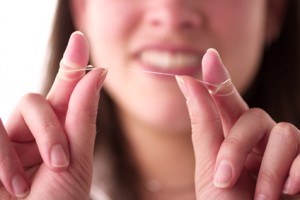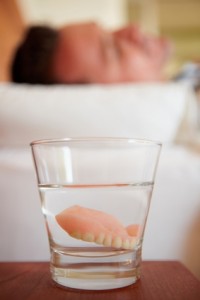 The basics:
Generally there are two types of floss: Rope and Tape. They are either waxed or un-waxed.
Tape: a flat string usually made of a smooth material: this is the type of floss that we recommend the most due to the ease of use between tight teeth and teeth with a lot of restorative work such as fillings and crowns.
Rope: this is usually a braided or round string or rope that can be covered in wax or not, depending on your preference. I tend to avoid this type of floss due to the difficulty of use. Often times if you have tightly contacting teeth this type tends to fray or break more often than a tape will.
Specialty floss and floss threaders: There are a series of flosses and floss threaders that are made specifically to be used around bridge work and braces. Super Floss is a brand that I recommend often for patients because it is a thick and spongy floss with a flexible plastic end that is relatively easy to use underneath bridgework and around orthodontic brackets.
Dental Flossers: these are small plastic handles with floss attached at the end, most often a rope type of floss. My opinion on floss threaders is, if you find that you can not or will not use any other type of floss then they can be used. But I rarely recommend them since you lack the ability to maneuver them around the teeth appropriately and can do a little damage to the gums if the patient is not careful when using them.
Water pics and Air flossers: these are electric tools similar to an electric tooth brush that either use air or water to force debris out from in between teeth and out from under restorative work. My opinion on these tools is that while I believe that they have improved water pics and air flossers immensely in the past few years, they are an adjunct to the use of regular floss. The use of regular dental floss is still the gold standard.]]>
The basics:
Generally there are two types of floss: Rope and Tape. They are either waxed or un-waxed.
Tape: a flat string usually made of a smooth material: this is the type of floss that we recommend the most due to the ease of use between tight teeth and teeth with a lot of restorative work such as fillings and crowns.
Rope: this is usually a braided or round string or rope that can be covered in wax or not, depending on your preference. I tend to avoid this type of floss due to the difficulty of use. Often times if you have tightly contacting teeth this type tends to fray or break more often than a tape will.
Specialty floss and floss threaders: There are a series of flosses and floss threaders that are made specifically to be used around bridge work and braces. Super Floss is a brand that I recommend often for patients because it is a thick and spongy floss with a flexible plastic end that is relatively easy to use underneath bridgework and around orthodontic brackets.
Dental Flossers: these are small plastic handles with floss attached at the end, most often a rope type of floss. My opinion on floss threaders is, if you find that you can not or will not use any other type of floss then they can be used. But I rarely recommend them since you lack the ability to maneuver them around the teeth appropriately and can do a little damage to the gums if the patient is not careful when using them.
Water pics and Air flossers: these are electric tools similar to an electric tooth brush that either use air or water to force debris out from in between teeth and out from under restorative work. My opinion on these tools is that while I believe that they have improved water pics and air flossers immensely in the past few years, they are an adjunct to the use of regular floss. The use of regular dental floss is still the gold standard.]]>
Posts
Many of our patients know that we consider fluoride an amazing tool. The increased use of fluoride has  changed dentistry radically over the past forty years or so. So although you probably are familiar with fluoride, this post is really to answer the question: Why do I need fluoride? What are the benefits? What are the risks? So lets start with the facts:
changed dentistry radically over the past forty years or so. So although you probably are familiar with fluoride, this post is really to answer the question: Why do I need fluoride? What are the benefits? What are the risks? So lets start with the facts:
Fluoride is a naturally occurring compound found in water, soil and food.
Fortifying drinking water has been recommended by the U.S. Public Health Service to aid in the prevention of tooth decay, they recommend adjusting the naturally occurring fluoride level of existing public and private water sources to reach the optimal level of fluoride which is 0.7-1.2 parts per million or milligram per liter. Fluoride helps prevent cavities by being absorbed into the enamel of the your teeth and fortifying it, making the enamel more resistant to decay and demineralization. This can help in preventing early weakening in the tooth structure and early decay.What are the risks of using fluoride?
The CDC has done numerous studies, the most common risk noticed is dental fluorosis if fluoride is consumed in a high amount for a long period of time during the development of the adult teeth. Dental fluorosis is pitting or mottling of the enamel of the teeth. Children 8 and younger are the most at risk for dental fluorosis. Also, There has been some speculation about a link between fluoride and osteosarcoma however over the past 60 years of fluoride use and studies no link has been established between bone health and fluoride.- The CDC has listed water fluoridation as one of the 10 greatest public health achievements of the 20th century
- The first city to adjust the level of fluoride in its water supply was Grand Rapids, Michigan on January 25, 1945
- Although not all water supply is fluoridated around 72.4% of the U.S. population receive fluoridated water.
- Aside from fluoridated water you can obtain fluoride from a multitude of sources. Such as, fluoride multivitamins for children, in some foods, as well as many mouth rinses and toothpastes.
- Fluoride is endorsed and recommended by the American Dental Association as well as many other state and local dental societies.
Over the last few years there has been an increase or reported cases of MRSA infections. Many of my patients ask me about the risk of oral MRSA infections and how it can effect them. Our mouths are home to over 300 different types of bacteria.  In a healthy mouth, these bacteria work together to create a healthy oral environment. But, as in any other system, if things go awry and the balance becomes upset then we find different types of bacteria take advantage of this and begin to thrive.
In a healthy mouth, these bacteria work together to create a healthy oral environment. But, as in any other system, if things go awry and the balance becomes upset then we find different types of bacteria take advantage of this and begin to thrive.
So does the average person have MRSA in their mouth?
Studies have shown that the population that has the highest incidence of MRSA colonization are elderly patients in nursing homes as well as patients with advanced malignant diseases suffering from reduced salivary flow rate.What can they do to reduce the amount of bad bacteria in our mouths?
MRSA tends to like to grow on the porous surfaces of dentures as well as being found in plaque in the mouth. Some studies have shown that a good way to clean MRSA infected dentures is with a chlorhexidine oral rinse as well as soaking the dentures in chlorhexidine for 10 minutes once a week. Dentures should be cleaned daily with a stiff brush and soap and water, not toothpaste. And even, if you wear dentures you should be cleaning your gums and remaining teeth as well. Some studies also suggest microwaving your dentures for 3 minutes. However, I don’t suggest this if you have any portion of your denture that is metal.What kind of risks are there if you have MRSA in your mouth?
There are no studies that offer clear associations of MRSA colonization in the mouth causing systemic and dental problems. Although, the bacteria having been found in some orofacial abscesses as well as some infections located on the gingiva and corners of the mouth commonly associated with denture wear. So although there have been few instances of this type of bacteria found in oral infections the concern is for the potential for these strains to re-colonize at other body sites or become a source of cross-infection to other patients or hospital/nursing home staff.The ecology of Staphylococcus species in the oral cavity; A. J. Smith, M. S. Jackson and J. Bagg Staphylococcus aureus in the oral cavity: a three-year retrospective analysis of clinical laboratory data; A.J. Smith, D. Robertson, M. K. Tang, M. S. Jackson, D. MacKenzie & J. Bagg MRSA infection; K. Valand & P.M. McLoughlin
]]>  Smoking is not only bad for your heart and lungs but your mouth too.
Here are the alarming statistics:
Smoking is not only bad for your heart and lungs but your mouth too.
Here are the alarming statistics:
- Smokers are three times more likely than non-smokers to lose all their teeth. This figure has not changed from a decade ago.
- Smoking can result in periodontal gum disease, bad breath, staining of the tongue and teeth, delayed healing and complications with certain dental procedures, plaque build-up, and a diminished sense of taste and smell.
- About 28,000 people are diagnosed with oral cancer a year and 7,200 die from oral cancer each year.
- It has been reported by the Academy of General Dentistry that a one-pack-a-day smoking habit can cost you the loss of at least two teeth every 10 years. Smoking can also lead to seven times the risk of developing gum disease compared to non-smokers.
- About eight out in ten people with mouth and throat cancers are tobacco users. On average, 40 percent of those with the disease will not survive more than five years after being diagnosed, as quoted by the American Dental Association.
- According to the American Cancer Society, it is estimated that about 8 out of 10 oral cancers could be prevented by avoiding both tobacco and alcohol use. Many of the chemicals found in tobacco can damage DNA directly. Scientists are not sure whether alcohol directly damages DNA but they have shown that alcohol helps many DNA-damaging chemicals get into cells more easily. This may be why the combination of tobacco and alcohol damages DNA far more than tobacco alone.

- If you’re using a manual brush, it should always be a soft bristle toothbrush. I wouldn’t recommend buying a hard bristle one unless you’re planning to use it to clean the grout on your bathroom tiles! Hard bristles are too harsh for teeth and not necessary to do an effective cleaning job.
- The proper technique is to move the brush over the teeth in a circular motion. Never use a front to back “sawing” motion.
- A typical brushing routine should include brushing at least two to three times a day for two minutes, breaking up the time evenly amongst the different areas of the mouth.
- If you’re using a manual toothbrush, we recommend switching to an electric one. They often have two-minute timers built in with a beep to remind you to switch to the next part of your mouth and give a nice uniform amount of pressure. Electric toothbrushes do most of the work and help you resist the urge to scrub too hard.
Frangella Dental
Offering advanced techniques in Cosmetic and General Dentistry in New York City.
200 W. 57th Street, Suite 1405
New York, NY 10019
(212) 245-2888
care@drfrangella.com
